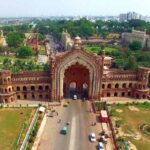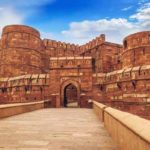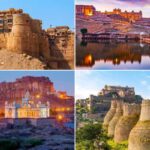Gwalior Fort, perched on a rocky outcropping overlooking Gwalior city, is home to a number of historic structures. It is one of India’s largest forts. It was built in the eighth century, according to historical records.
Gwalior Fort, perched on a rocky outcropping overlooking Gwalior city, is home to a number of historic structures. It is one of India’s largest forts. It was built in the eighth century, according to historical records. The fortress and the city have played an important role in the development of the North Indian kingdoms. The Mughal Emperor Babur (1483–1531) is said to have mentioned it as “the pearl in the necklace of Hind’s forts.”
The fort, which has been dubbed the “Gibraltar of India,” offers a panoramic view of the old Gwalior town to the east. Raja Man Singh Tomar constructed the fort in the 15th century. The past of Gwalior’s fort has seen many ups and downs. The Gwalior fort passed through many rulers over the course of nearly 500 years. It passed from the Tomars to the Mughals, Marathas, and the British. The British eventually handed over the fort of Gwalior to the Scindias.
The Teli-ka-Mandir is the most well-known of the Gwalior fort’s temples. This temple is notable for its lavishly sculpted exterior, which was constructed in the Dravidian style. The Saas-Bahu Temples (two pillared temples that stand side by side, one larger than the other) are also interesting. The Man Singh Palace is one of the Gwalior fort’s most magnificent structures. Man Singh constructed it in the 15th century. Mughal emperor Aurangzeb imprisoned and later assassinated his brother Murad in the same palace.
Then there’s the gruesome Jauhar Kund, where after the defeat of Gwalior’s king in 1232, the harem’s women burned themselves to death. The Karan Palace, the Jahangir Mahal, the Shah Jahan Mahal, and the Gujri Mahal are among the other notable palaces within the Gwalior Fort (built by Man Singh for his favourite queen, Mrignayani). Gwalior Fort also occupies a unique place in the human civilization as the place which has the first recorded use of zero ever. Also referred as ‘Shunya‘ in sanskrit, this site is of mathematical interest.
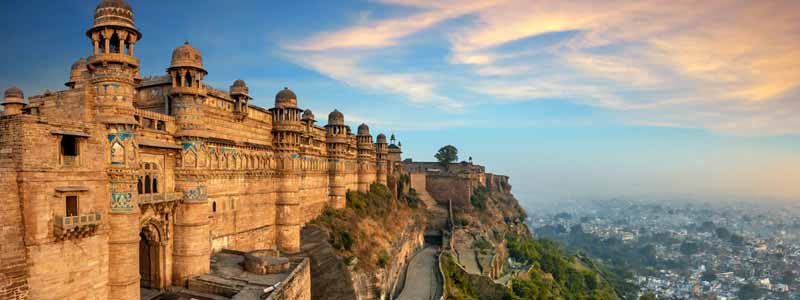
The History of the Gwalior Fort
According to historians, there is no clear evidence that the fort was built when it was. According to local tradition, it was founded in 3 CE by a local king named Suraj Sen. Gwalipa, a wandering saint, came to the fort and met the king, who was suffering from leprosy. When Gwalipa offered him water from a holy pond (now known as Suraj Kund), he accepted and located within the fort complex), he immediately became healthy again.
The king called the fort and the town after the saint as a token of his gratitude. The saint then bestowed the title of ‘Pal’ (protector) on the king and assured him that the fort would remain in his family’s hands as long as he and his family retained this title. Following this, the fort was run by 83 of Suraj Sen’s descendants. However, the fort was lost because the 84th king, Tej Karan, did not have the title.
Visitors can learn about the fort’s history from monuments and inscriptions within the fort, which date back to the 6th century. During that time, the fort was ruled by Mihirakula, a Huna emperor. Gurjara-Pratiharas conquered the fort in the 9th century, ruled it, and founded the Teli Ka Mandir.
After three centuries of being invaded and controlled by a couple of Muslim dynasties, the Tomars finally took control of the fort in 1398. Maan Singh, the last and most illustrious Tomar king, built a number of monuments within the fort complex. During his reign, the magnificent turquoise blue-tiled Man Mandir Palace was constructed. In addition, he designed a separate palace for his wife, Mrignayani; this structure is called the Gujari Mahal and is now a state archaeological museum. When Ibrahim Lodi attacked the fort in 1516, he defeated Maan Singh, who died, and the Tomars lost the fort.
The Mughals ruled the Gwalior Fort for a short time until the Marathas captured it and handed it over to the East India Company. Following that, there were several frequent changes in control between the Marathas and the Britishers. Finally, in 1844, the Maratha Scindia family of Gwalior occupied the fort as a protectorate of the British government.
The fort saw heavy fighting during the 1857 uprising, when Rani Lakshmibai (the Queen of Jhansi) came fighting from Jhansi to Gwalior and found refuge within the fort. She jumped from the fort on her horse and gave her life after fighting with the Britishers for days. The Scindias ruled the city until 1947, when India gained independence, and built a number of monuments.
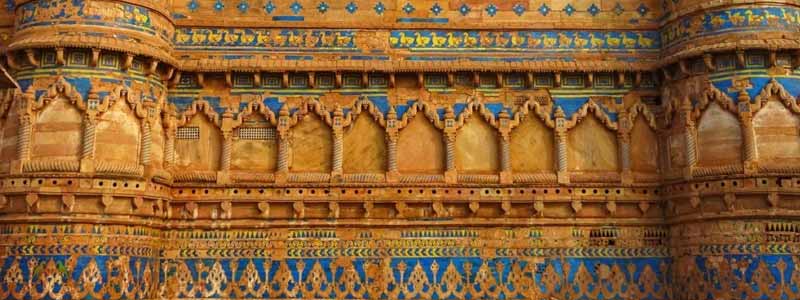
Architecture Of Gwalior Fort
The majestic architecture of the Fort of Gwalior, which is surrounded by sandstone concrete walls, dominates the entire city of Gwalior. The fort’s exquisite carvings include the second-oldest reference to the number “Zero,” which can be seen at the fort’s tip. The magnificent fort’s architecture has a fascinating history attached to it, which can be seen in two sections. Temples, palaces reflect the fine artistry in the hands of the workers who created this beautiful palace. The exterior is also sculpted exquisitely containing blue ceramic tiles.
Light And Sound Show At Gwalior Fort
Every evening, the magnificent and remarkable sound and light show held in the Fort of Gwalior will dazzle your eyes. The show is very well done, so it will seem that you are witnessing the history of the fort as you watch it. Raja Man Singh and Queen Mrignayani’s love storey is depicted in the film. The show is conducted in the amphitheatre in Man Mandir and the timings of the show are: Hindi Show starts at 7:30 PM in the evening and English Show begins at 8:30 PM in the evening.
Facts About Gwalior Fort
It’s fascinating to learn that the fort you’ll be visiting is part of one of India’s largest forts. You’ll be surprised to learn that the second-oldest reference to zero in mathematics can be found in a carving in a temple in Gwalior’s Fort. The inscription in the Gwalior fort dates back to about 1500 years. Isn’t it thrilling? The fort dates back to the sixth century. You are going to witness many palaces, temples, water tanks like Shah Jahan, the Karan, Man Mandir, the Gujari and the Jahangir.
Gwalior Fort Timings And Entry Fee
You can visit the Gwalior fort anytime from 6:00 AM in the morning till 5:30 PM in the evening. On an average it will take at least 3 to 4 hours to travel the entire Gwalior fort. Don’t miss on the timings of the light and sound show which is indeed beautiful. For Indians, the entry fee is INR 75 per person and for Foreigners its cost INR 250 per person and for the entry of children below 15 years of age, it is free of cost.
Best Time To Visit Gwalior fort
The best time to visit the Gwalior Fort is during the autumn and spring season, that is between October and March. One can also enjoy the visit during the time of monsoon when the surrounding is verdant green, and the air is fresh and crisp.
How To Reach Gwalior Fort
The best way to reach the Gwalior Fort is through auto-rickshaw which can go up to the Urvai Gate, the western entrance of the fort. There are two approaches to the fort, the second one being the eastern entrance which does not allow any vehicle. Both the paths are steep treks after one point. However, the stunning view of this striking fort from the eastern side makes the whole trip worthwhile. Make sure not to miss the beautiful rock sculptures on your way down from the western side.


